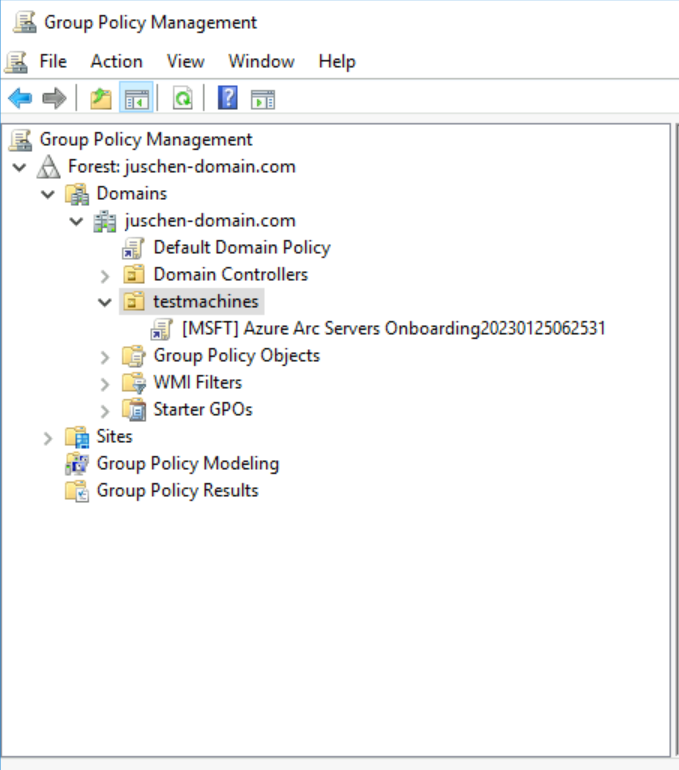Secure, scalable, and simple onboarding to Azure Arc-enabled servers using Group Policy

Whether its Microsoft Defender for Cloud’s Security Posture Management capabilities or Azure Automanage Machine Configuration’s Guest-OS level governance capabilities or Update Management Center’s patching capabilities, Azure Arc-enabled servers helps customers achieve consistent security and compliance across their hybrid infrastructure. With thousands of servers spread across subsidiaries and environments, it can be challenging to have the asset inventory needed to onboard to Azure Arc. Yet one solution, a favorite among our customers, most often traverses across disparate environments. You guessed it, that solution is Active Directory. Using Active Directory’s Group Policy engine, IT admins can point and click to onboard hundreds or even thousands of servers to Azure Arc.
Onboarding at scale is simpler than you think. First, set up a service principal, a limited identity restricted to the Azure Connected Machine Onboarding role. Next, prepare a remote share to host the Azure Connected Machine agent installer and configuration file. Finally, identify and develop a landing zone in Azure (region, subscription, etc.) for where the Azure Arc-enabled servers will be onboarded.
Once you’ve completed the pre-requisites, you can go to Azure portal and under the option to onboard multiple machines, you’ll be provided with the ability to onboarding using Group Policy. Here you’ll be provided with access to a replicable Group Policy Object (GPO) project structure and a pre-populated command that will fill generate a scheduled task with your Azure information. The command handles encryption of the service principal secret, generating a GPO that can be readily applied.
Now that you’ve successfully created the GPO, simply link it to the desired Organizational Units from the Group Policy Management Console (GPMC). Within 10 to 20 minutes, the Group Policy Object will be replicated to the respective domain controllers and the GPO will trigger the scheduled task to onboard servers to Azure Arc. Once onboard to Azure Arc, start deploying Azure services like VM Insights, Windows Admin Center, or Change Tracking for modernized management of your Arc-enabled servers. If you don’t know where to get started, consider using Azure Automanage Machine Best Practices, a service that eliminates the need to discover or configure the right Azure services to secure, monitor, and govern your Arc-enabled servers.
Helping IT administrators see the forest from the trees, Azure Arc’s single pane of glass affords unprecedented visibility. Your seat at the world’s computer is now just a Group Policy away.
Published on:
Learn moreRelated posts
Fabric Mirroring for Azure Cosmos DB: Public Preview Refresh Now Live with New Features
We’re thrilled to announce the latest refresh of Fabric Mirroring for Azure Cosmos DB, now available with several powerful new features that e...
Power Platform – Use Azure Key Vault secrets with environment variables
We are announcing the ability to use Azure Key Vault secrets with environment variables in Power Platform. This feature will reach general ava...
Validating Azure Key Vault Access Securely in Fabric Notebooks
Working with sensitive data in Microsoft Fabric requires careful handling of secrets, especially when collaborating externally. In a recent cu...
Azure Developer CLI (azd) – May 2025
This post announces the May release of the Azure Developer CLI (`azd`). The post Azure Developer CLI (azd) – May 2025 appeared first on ...
Azure Cosmos DB with DiskANN Part 4: Stable Vector Search Recall with Streaming Data
Vector Search with Azure Cosmos DB In Part 1 and Part 2 of this series, we explored vector search with Azure Cosmos DB and best practices for...
General Availability for Data API in vCore-based Azure Cosmos DB for MongoDB
Title: General Availability for Data API in vCore-based Azure Cosmos DB for MongoDB We’re excited to announce the general availability of the ...
Efficiently and Elegantly Modeling Embeddings in Azure SQL and SQL Server
Storing and querying text embeddings in a database it might seem challenging, but with the right schema design, it’s not only possible, ...



